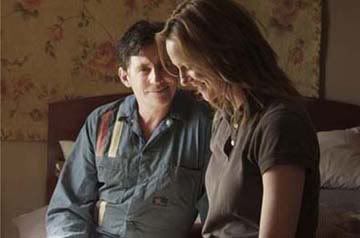

Archive: "Jindabyne" (2007)
"Jindabyne," titled for the lakeside city where the movie takes place, is based on the short story "So Much Water So Close to Home" by Raymond Carver, and Australian director Ray Lawrence has transformed the story into a movie that is uniquely Australian in its themes, ideas, and setting. The camera sweeps over the sometimes ominous landscape, full of flowing rivers, tall mountain peaks, and barren lands. The cinematography is quite beautiful, and so is the acting that comes along with the rest of the film.
Claire (Laura Linney) is an American wife of an Australian fisherman, Stewart (Gabriel Byrne); their troubles as a couple are surrounded by neighbors, friends, and family who also have troubles of their own. They both have the usual small-time jobs you would find in a small town like Jindabyne, Claire working as a clerk in a drugstore, and Stewart running a gas station. They have an unexplained patch of history in their marriage where Claire got ill and left because she wasn't able to care for their only son. Like many other aspects of their relationship, this is never really explained.
The only highlight in Stewart's year is going on a big, annual fishing trip with three other buddies at some river deep in a remote national park. While there, they stumble across the dead body of an Aboriginal woman. The immediate response of the group of men is never shown or understood, and they decide to not let this be an interruption to their fishing trip and that they'll take care of it once they get home. Once they tell the police about it, however, they, and the public of the small town, can't understand how the men could've continued to fish there. The last person to find out is Stewart's husband, Claire, which puts a strain on her understanding of her husband's actions.
The movie presents Claire's side of the argument with the most clarity; she returns back to the subject over and over again, pressing her husband further on the issue. It's an attempt to get a grip on the matter, to find out if she's living with a heartless man, and to find some way to make amends with the entire ordeal. This performance is left in the very capable hands of Laura Linney, who is the powerful center of this tale of lost morality. It's best to keep your eye on her very emotional and taut performance because it's by far the most admirable factor among the rest of the film's sometimes slow-moving and unfocused feel.
This best feature, along with the other central performances, gets somewhat lost in the murk of other extraneous elements of the plot. The filmmakers seem to have a lot to say about race, religion, abortion, mental illness, middle age, and community life. The fact that the woman in the water is Aboriginal brings up the race factor and the question of whether or not the men would've acted quicker had she been white. The movie gets weighed down by these extra factors, which all seem heavy-handed.
Also interesting to note is that the movie sometimes even feels like a thriller. There is always the murderer of the young woman lurking about, and there are plenty of scenes that lend themselves to make the viewers believe that something bad is going to happen. Also something to note is that although meant to be a character study, some of the most important aspects of these characters are left not fleshed-out.
"Jindabyne" is an intelligent, finely observant, and haunting portrait of a small town torn apart by the rage that surrounds a tragedy. It's a peculiar film; one that is very bleak, quiet, and in this subdued tone, tells a fractured story about humanity and the occasional struggle in finding it. And the movie's ending, too, is just a wry enough of a conclusion that brings everything full circle with just the right amount of karma.





No comments:
Post a Comment